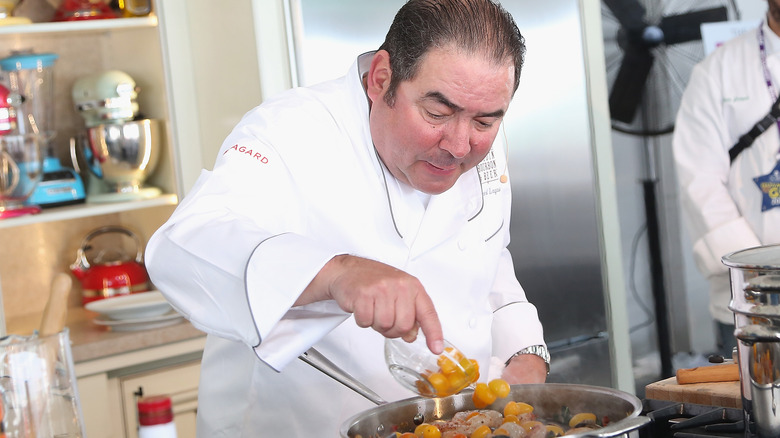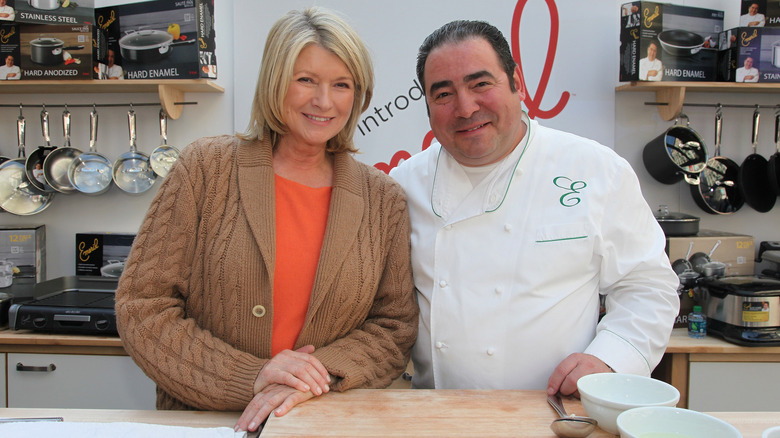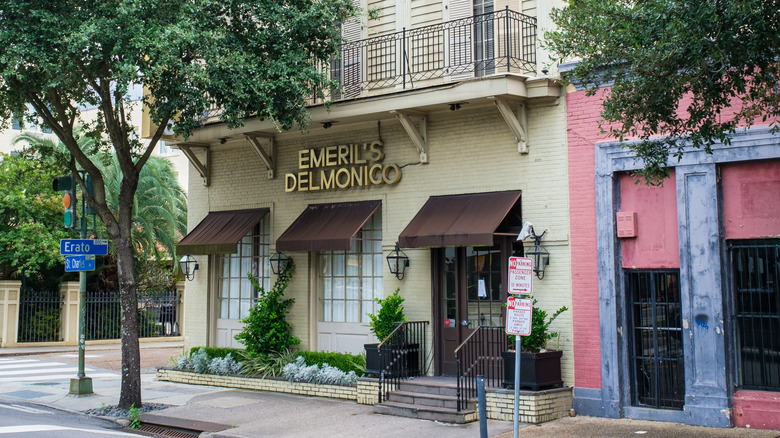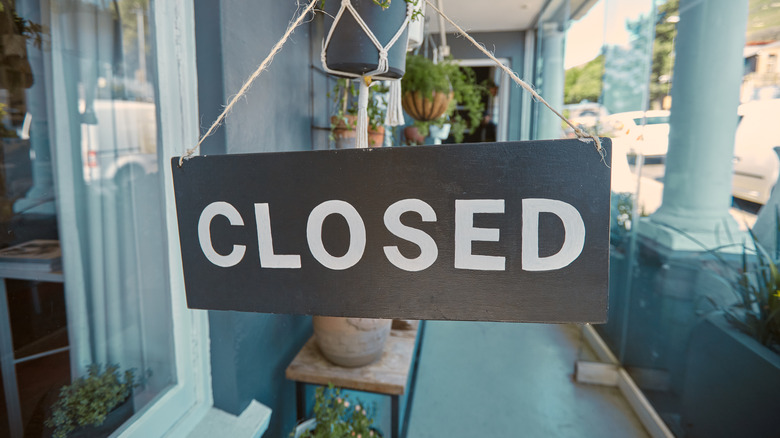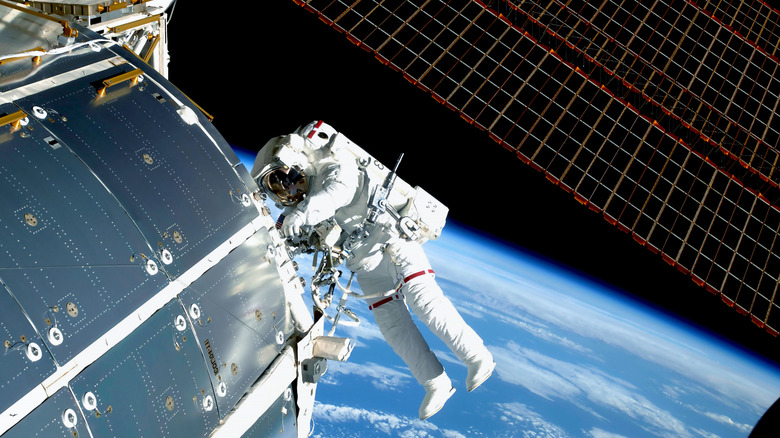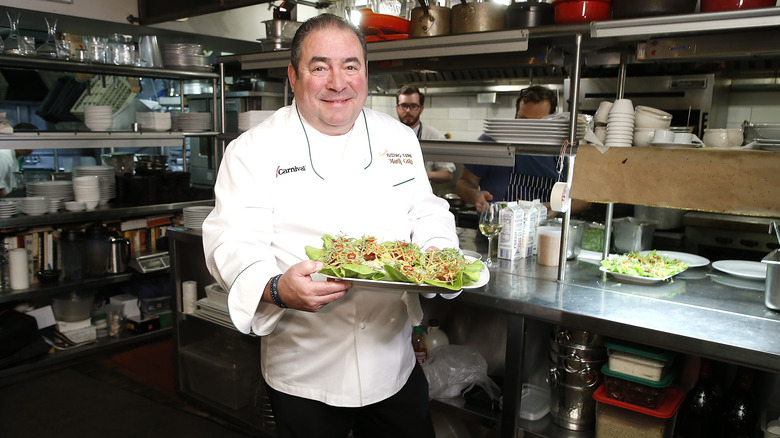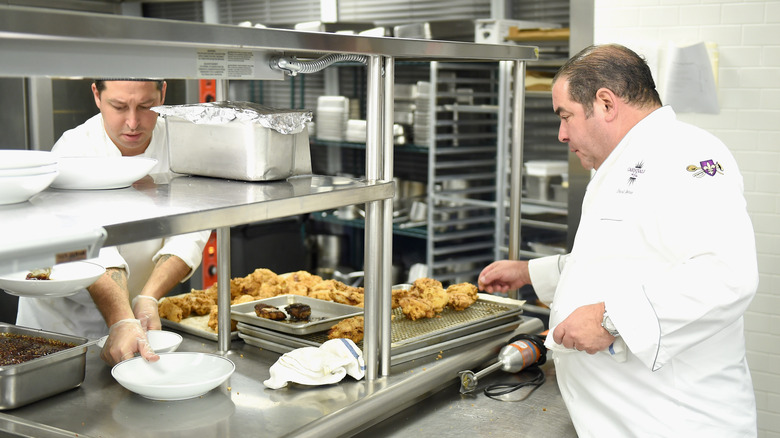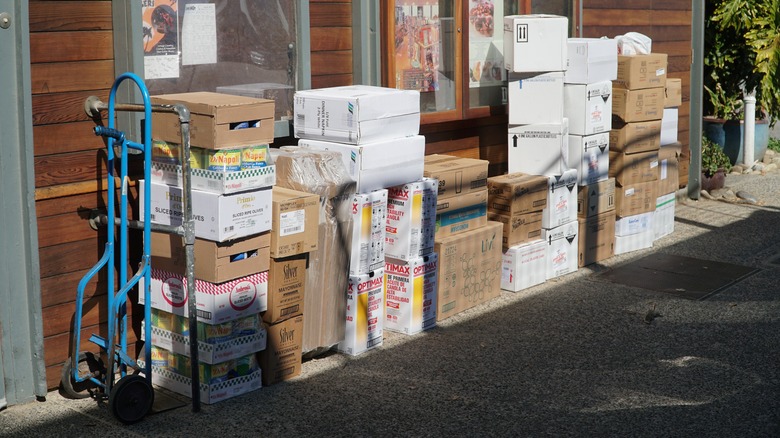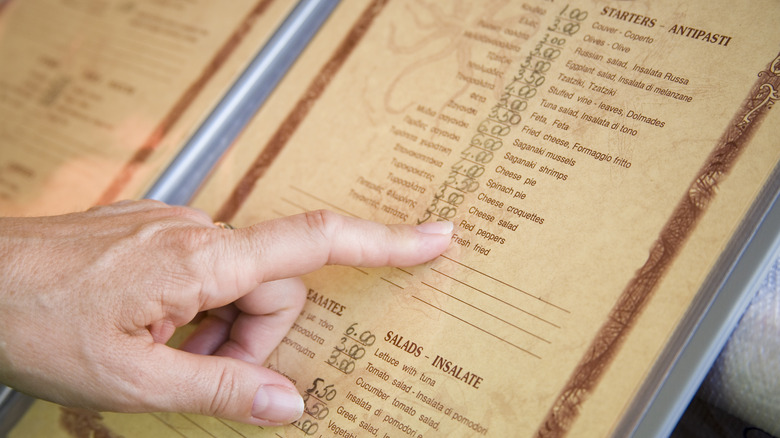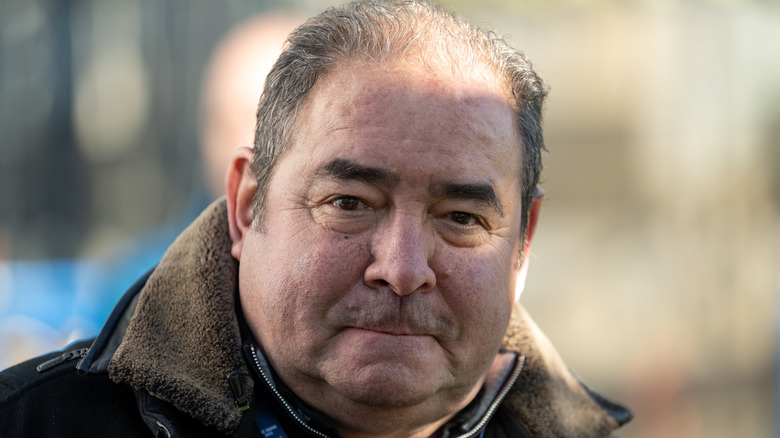How Emeril Lagasse Pulled Himself Out Of Restaurant Ruin
Emeril Lagasse is an absolute marvel of culinary creativity and respect. From his early days at Commander's Palace to receiving food reviewer Gene Bourg's coveted five-bean review to being one of the Food Network's top stars, Lagasse just hasn't stopped, and he intends to keep going for as long as he can. However, he has had his low points, from restaurants closing to shows being canceled. But those times haven't occurred because of mismanagement or related issues that often take down companies.
In Lagasse's case, most of what has badly affected his restaurants has been external and uncontrollable. He's dealt with Hurricane Katrina's devastation, nationwide recessions, and the widespread closures of the pandemic, only to bounce back with more good food and entertaining shows. He's lucky but also has very good business sense and a supportive network of colleagues and employees, and those have been key to how Lagasse pulled himself out of restaurant ruin.
Martha Stewart came to his rescue
What was likely Lagasse's closest brush with restaurant ruin came in 2005, when Hurricane Katrina hit New Orleans. Three of Lagasse's restaurants were destroyed, along with his house in Mississippi. He spent a huge amount of money working to fix his restaurants, he had to deal with a host of uninsured losses that topped $1.2 million, and he had no income from those restaurants coming in to replace what he was spending. Not to mention his Food Network shows were canceled soon after, so his company was hurting badly.
That's when Martha Stewart Living Omnimedia stepped in. In 2008, the company was looking for partners and bought the rights to much of Lagasse's brand for cash and stock, although he retained full control of his restaurants. The money provided by Omnimedia allowed him to pay off debts and get his company back on track financially. Since then, Omnimedia and Lagasse's brand have been sold a couple of times, but as Lagasse told Esquire in 2022, the current owners are "some very nice Wall Street guys."
He's opened and run many restaurants simultaneously
While it's true that even the best, most successful restaurant chains can fail quickly, the fact remains that diversification is best when it is possible. Being able to open more restaurants that bring in more profits is a good thing (if you can handle the additional locations well). You can roll those profits right back into your restaurants and into accounts that can support the establishments during times when business might not be all that great.
Lagasse has opened restaurants across the U.S. from Louisiana to Nevada to Pennsylvania and beyond, and while he's had to close many over the years, too, he hasn't let the restaurant side of his business remain stagnant. He's looked for different formats and cuisines that give customers unique experiences wherever they go. This, plus his good sense of which restaurants should remain open versus which should be closed, has helped keep his company going through the years.
He hasn't opened and run more restaurants than he can handle
One way to ruin a successful company is to overextend it, expanding much too fast and too far. Lagasse has gone on the record before to state that he constantly turns down restaurant proposals because he knows it would stretch him too thin and make him miss time with his family. After several of his restaurants had to close during the pandemic, he was careful about choosing which would reopen, determining whether he wanted to reopen them because he thought it would work out or because he just wanted to say it was open.
Even before the pandemic, though, Lagasse was cautious. In 2013, he told NOLA.com that he'd open more restaurants in the future, including possibly in New Orleans, if the circumstances were right. As he put it, "We're not out to set any records." He admitted that he had to be really excited about an idea, too; at that time, he had people urging him to open something in Asia, but he wasn't sure because of how far away the restaurants would be. None of his restaurants opened in Asia, so it looks like he paid attention to how uncertain he felt.
He hasn't forced restaurants to stay open
Chefs and restaurant owners need to be tough and not fold at the first sign of financial issues. However, they also need to be realistic about the troubles a restaurant is having; sometimes, keeping a treasured location open just isn't financially feasible. Lagasse has been realistic and has closed locations that weren't performing well for one reason or another, such as when he permanently closed his Las Vegas sports bar in July 2022 during the COVID-19 shutdowns. In fact, he closed seven restaurants in total as a result of COVID. But he acknowledges that everyone had a tough time with the pandemic, not just his business.
The pandemic decimated the restaurant industry, with close to 80,000 restaurants (about 10% of the total in the country) permanently shuttering just as of early 2021. In some states, like California, the toll percentage was even greater, with about ⅓ of restaurants closing. Add in the supply chain and labor problems that followed, and keeping underperforming restaurants open becomes a financial drain. Lagasse recognized what was happening early on and decided his restaurants shouldn't be forced to deal with the prolonged aftermath of the lockdowns.
He's diversified new gigs
One way to ensure you get customers is to stay in the public eye and expand what you do so that more people have a chance to go to your restaurants or become aware of your name. Lagasse has continually cultivated more and more gigs and made sure that he was seeking diverse venues. Sometimes those diverse venues were trailblazing, such as the time that NASA asked him to create meals for the International Space Station. He also got a TV special out of it on the Food Network, in which he was able to speak with the astronauts who'd eaten his food.
But he's also diversified through more traditional routes, such as continuing to do TV shows on newer channels like Roku+. He's opened a couple of outposts on cruise ships so that people can eat his food while at sea. This has helped keep his name and food very visible to the public, even as he had to shut down restaurants due to things like the pandemic.
Lagasse has been very good about constantly seeking out new forms of financial support. Not only does he have those contracts with cruise lines and his other restaurant and cookbook income, but he also has income from cookware sales, partnerships and licensing with food and cookware companies, even more TV shows through an expanded universe of channels, guest spots on other shows like Masterchef, and more. Sometimes those resources don't last, like when he had a short-lived and badly reviewed sitcom in 2001 based on his life; he shot 10 episodes, but only seven were aired, and the show was universally panned for less-than-stellar acting. But every little bit helps to stabilize his company in a field that's inherently unstable.
He's diversified his financial resources
Running several restaurants is expensive, and it's not unusual for new chefs to get a lot of their funding right out of their own savings accounts. Money to run Lagasse's restaurants may come from his corporation now and not out of his personal accounts, but given the financial setbacks that Lagasse has faced that were out of his control, he can't rest that easy regarding financial resources. Lagasse already had some diverse financial income from books and TV shows, but as Hurricane Katrina showed, those weren't enough.
Lagasse has been very good about constantly seeking out new forms of financial support. Not only does he have those contracts with cruise lines and his other restaurant and cookbook income, but he also has income from cookware sales, partnerships and licensing with food and cookware companies, even more TV shows through an expanded universe of channels, guest spots on other shows like Masterchef, and more. Every little bit helps to stabilize his company in a field that's inherently unstable.
He's created a company full of longtime, loyal employees who get along
Forget those fictional shows that show intrigue and betrayal in professional kitchens; you won't find that behavior in Lagasse's establishments. He's loyal to his employees, they're loyal to him, and he's guided many into long-term careers with his company. It's common to find higher-ups who started a couple of decades ago as bussers, and when Hurricane Katrina hit and destroyed much of New Orleans, Lagasse quickly found places for his staff to work in other cities. Everyone is invested in making the restaurants a success, and the longevity of so many employees there means that everyone's familiar with how they all work. That goes a long way toward avoiding the kind of infighting that can sabotage meal service.
Lagasse's own employees freely mention how the loyalty people have toward each other is partly responsible for the restaurants' success. The food may be fabulous, but if you don't have loyal employees working for a boss who's loyal to them, then success will be much harder to achieve.
He visits and cooks at his restaurants
It would have been very easy for Lagasse to leave his restaurants to random management companies while he went off and did nothing but TV shows and book tours. However, that's not his style. While he has other chefs running the kitchen at each location, recently Lagasse turned chef patron duties at the original Emeril's restaurant over to his son. While he spends much of his time running a foundation while also appearing on TV shows, he's got a long track record of visiting and cooking at his restaurants.
Lagasse is big on being part of a team, and visiting his restaurants and working in those kitchens allows him to get to know everyone who works for him. His staff have pointed out that he shows up even though he doesn't have to, and he's made it clear that whatever he wants his staff to do will never be something he himself isn't willing to do. That level of involvement in his restaurants and that level of familiarity with the staff go a long way toward ensuring the restaurants are running smoothly and making customers happy.
He keeps a small core of favorite recipes but regularly updates menus and concepts
Planning a restaurant menu can be tricky as you want to ensure people can get their favorite dishes without getting bored with the selection. You also want to add new dishes to the menu and get creative without making your regular customers look elsewhere for more familiar flavors. Lagasse ensures that the menus at his restaurants have a core list of customer favorites along with seasonal and other options that change every few months. As Lagasse told CNN in 2011, "competition in the restaurant business is too stiff for us not to keep our menus evolving."
Lagasse is also open to changing the dining experience at his restaurants along with the menus. For example, when his son E.J. graduated from culinary school and finished several apprenticeships, he (E.J.) started working at Lagasse's original restaurant. He soon helped his father change the entire dining experience at Emeril's, making it smaller by allowing only 60 customers per night and creating a set of tasting menus. Customers can still get favorites like banana cream pie, however. And in 2023, the two revamped the restaurant again, this time improving the physical environment to help increase efficiency. They also added a new section focusing on small-plate items.
He separates administrative duties from restaurant staff
When you eat at a restaurant, you want the chef and kitchen crew to concentrate on getting the food right, not on budgets, payroll, advertising, or any of the administrative tasks that go along with running a restaurant. Lagasse has set up his restaurants in a way that shuttles all that administrative work to a central office away from the restaurants specifically so that the chefs and staff at each restaurant can focus on the food and customers.
Chefs still have to deal somewhat with inventory because they need to know what they have on hand in order to be able to cook whatever's on the menu. But the need to fill out order forms, choose and configure inventory management systems, look for suppliers, negotiate prices when possible, and more all cut into cooking and menu planning time. Remember, you don't take inventory once in a while; in a restaurant, you do it at least once a week, if not once a day. If you're tracking food loss, you have to take daily inventory. You don't find one supplier and leave it at that; you often have to keep finding suppliers as supply chains jam up or bad weather takes out a particular harvest. Moving as much of the work as possible over to a different office frees up a lot of time and brainpower.
He's conscious of his customers' budgets
Something that's worked for Lagasse has been his conscious effort to keep his customers' budgets in mind while also ensuring that his restaurants are among the nicer ones to enjoy. In fact, in the mid-2010s, Lagasse plainly stated that he couldn't charge $300 per person and recognized that a simple dish that didn't cost much could be a special occasion meal for someone. He's also been vocal about worries that eventually there will be only high-end and fast-food or chain restaurants, but nothing in the middle.
Cost is relative, so the prices at Lagasse's restaurants aren't universally praised as low. But the reviews that focus on price are more complimentary than not – and the complaints are relative themselves. For example, one reviewer didn't like that Lagasse's restaurant at Universal Orlando Resort in Florida was the most expensive of the available dining options, even though the prices wouldn't be out of place at any average sit-down establishment. To be fair, they were likely already spending a lot of money just to be at the resort, so looking for lower food prices is understandable. But many other reviews have called prices at his restaurants — even at Universal – a variation of reasonable or affordable.
He does not give up
Lagasse's career no doubt owes some of its success to luck and being in the right place at the right time, but a very large part of it is due to persistence. Look at all of the obstacles that he faced, and you'll find that he just didn't give up. From convincing cautious banks to give him a loan to open his first restaurant, to weathering misguided TV appearances, to not giving up after Hurricane Katrina or the forced closures during the COVID-19 pandemic, Lagasse's history has been one of persisting.
Lagasse openly credits persistence as one of his secrets of success, and he claims that his mentor, Ella Brennan, was responsible for teaching him to never stop. Her philosophy was to try a little more each day, reasoning that planning ahead made for better performance overall. He says she taught him "to leave [his] ego at the door. ... To learn from your mistakes and not be afraid to make them, just as long as you learned from them." Despite some low points that would have made us mere mortals flee the restaurant business, Lagasse has been determined to keep going, and the food world is the better for it.
